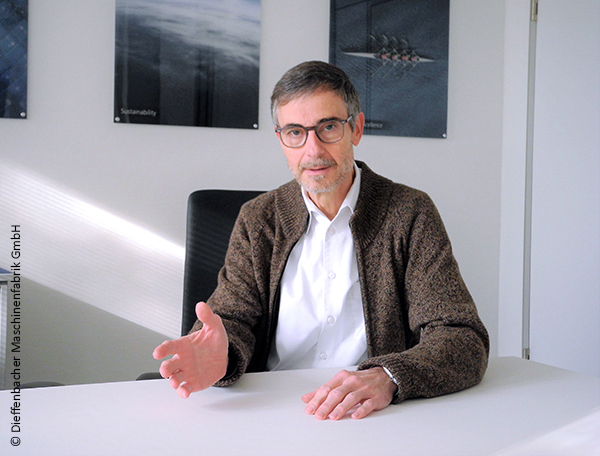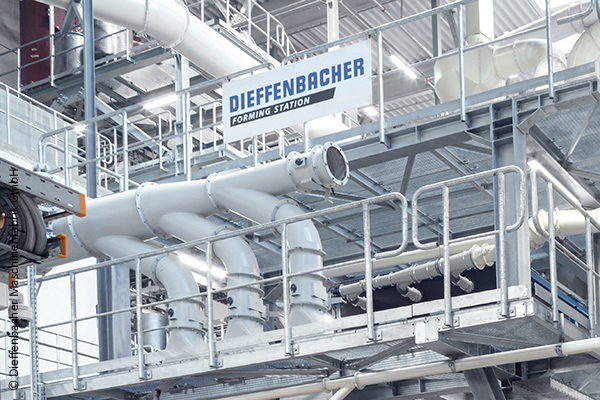
|
System-neutral consulting makes selecting a PLM system easierAn Interview with Matthias Rebel Dieffenbacher manufactures machines and plants for the production of wood-based panels, composites and metal components as well as for recycling wood. The company also offers its customers a digital platform for monitoring and analyzing their press systems and plants. Matthias Rebel, Director Technical IT Systems, explains the challenges that the company faces when it comes to modernizing its heterogeneous PLM landscape. 
Question: Mr. Rebel, what is Dieffenbacher's most profitable and fastest-growing business sector? Rebel: It is definitely the wood sector. There are not many companies in the world that can produce wood-based panel plants as large as ours. Forming is a more difficult business because the automotive market is currently undergoing a change and competition is somewhat tougher. And recycling is a relatively new business unit, initially focused on the processing of waste wood and now also serving new markets such as plastic, PU foam or carpet waste. Question: What challenges do you face in product development, especially with regard to new service offerings and business models? Rebel: As the head of IT, I’m responsible for internal digitalization. We have a separate body for external digitalization, i.e. everything related to digital business models and services, of which I am a member but not the driving force. What I can say, however, is that we offer a platform called EVORIS that provides our customers with digital added value. Question: Are customers already asking you for a digital twin of the plants? Rebel: The question is what you mean by the term “digital twin”. We make 3D models of the complete plant in the sales process, which makes it easier for the customer to envisage what their plant will look like. Since the Corona pandemic, virtual commissioning has become more and more important during plant commissioning. Then we offer them digital added value and potential savings for ongoing operations with EVORIS. We also have to document our plants properly, with maintenance plans, spare parts lists, etc. But mapping the entire plant, which measures the size of several football fields and has hundreds of thousands of components, one-to-one in a digital twin is unrealistic. This can certainly be done if only a single machine is involved. Nevertheless, we also purchase a lot of systems, and each supplier provides the information a slightly different way. I estimate that we purchase 60 to 70 percent of our systems. 
Question: What requirements do all the issues relating to digitalization place on your PLM architecture? What additional capabilities do you need? Rebel: The colleagues in automation, who deal with external digitalization, participated in the workshops held with PROSTEP and added their requirements. One key requirement is that we want to integrate electrics and mechanics more tightly in the future. We currently have a lot of mechanical BOMs in our PLM system, but the electrical components are kept somewhat more separate. We want to improve integration to ensure that we are able to quickly derive specific lists, e.g. of the sensors, from the central PLM system. First and foremost, the solution has to be practicable to ensure that the engineers actually work in line with the target processes and enter their data. If it takes longer than it does today, they won't do that. Question: Is it sometimes the case that extra effort is required early in the process, while the benefit is gained later? Rebel: From a business perspective, it may be fine for one department to invest more time and effort and for five other departments to benefit from this work later, but you also have to be able to implement it in practice. To do this, you have to be able to shift the resources accordingly. Otherwise, you’ll quickly encounter resistance. Question: What role does PLM play in your current IT landscape when it comes to interaction with other enterprise applications? Rebel: In our case, it’s pretty clear: We have two core systems, a PLM system and our SAP system, which are linked bidirectionally. They are the backbone of our IT. Both systems run in our own data center and have been in use for mor than 20 years. It’s clear that we will be migrating to SAP S/4HANA, which means that the future PLM system must also interact cleanly with SAP S/4HANA. Question: Which PLM system are you currently using? Rebel: On the one hand, an Agile system from Oracle, whose lifecycle ends in 2027, which is why we need a new tool. In addition, we also have at one of our subsidiary sites a little "Gaulish village" that uses PTC Windchill for CAD data management. The reasons are historical and because we use Creo as our 3D design system. That is why we do not want to simply roll out a new tool, but rather take a system-neutral look at which requirements we currently have and which new requirements will arise from topics such as external digitalization. We brought PROSTEP on board as a consultant to ensure that this was done properly together with the specialist departments, and we are now taking the next step with the tendering process. Question: What does your future PLM strategy look like? Do you already have something along the lines of a development plan? Rebel: No, but the modernization of the SAP and PLM systems at our company is a joint initiative being carried out under the auspices of a management body using a common roadmap. That is because we didn't want to have two project teams optimizing their own subprocesses instead of the overall process. And this roadmap also includes the selection of a PLM system and, if it’s a separate PLM system, its connection to SAP S/4HANA. What I can definitely say with regard to our PLM strategy is that in the future we want to have a uniform PLM system. That is why it's so important that the selection process be performed in a system-neutral and formally correct way in order to avoid the creation of different camps. This is ensured, among other things, by the consulting services provided by PROSTEP. Question: It would appear that finding a common denominator is the biggest problem in the context of modernizing your PLM landscape? Rebel: That’s right. It’s important that everyone feels included and understands why we decided on a specific system. A variety of different machines are installed in our wood-based panel plants, and each location has slightly different requirements. But from a business and IT perspective, we don't want to operate two systems. If you think about moving products internally to a different location, it’s much better if you have the same system and the same processes. 
Question: You are putting your faith in SAP S/4HANA, which is a cloud-based system. Is PLM from the cloud also a topic of interest for you? Rebel: You can run SAP S/4HANA both on premise and in the cloud, and we have not decided the option yet. We have two small data centers of our own and operate a number of other systems on premise, but we are open to the cloud. It’s ultimately an economic issue. The cloud also has to function well in terms of performance and latency. Our departments are rather spoiled in this respect as our systems are very efficient. As far as PLM is concerned, I could envisage the models and other documents being stored on site on servers but the data and application running in the cloud. Question: What benefits do you expect from greater end-to-end digitalization in your PLM processes? Rebel: One very clear expectation is that investing money in this will make us more efficient. We want the same number of design engineers and technicians to process more orders, in other words, we want to be able to move through the design process faster by increasing automation. At the moment, we are in the fortunate position of having the largest order backlog ever. This is, at the same time, a challenge because our specialist departments are very much involved in day-to-day business and at the same time are expected to deal with the new PLM world – a difficult balancing act. Question: Your systems are very customer specific. Is any effort being made to reduce your engineering outlay by increasing the level of modularization? Rebel: We’re already doing that but instead of modularization, we talk about building blocks. We have stored certain assemblies as ready-made building blocks with all the parts lists, drawings, etc., which the sales department can use. However, if a customer has individual requirements, we can accommodate them, which means that we have a process that is a combination of configure to order and engineering to order. The new PLM system must make the creation and integration of these building blocks, or modules, even more efficient. Mr. Rebel, thank you very much for talking to us. 
About Matthias Rebel Matthias Rebel has been working in IT at the Dieffenbacher Group, which has its headquarters in Eppingen, since 1988. During this long period with the company, he has been involved in the introduction of a wide range of IT systems. Today, he is responsible for technical IT systems such as PLM and CAD. |
|
| © PROSTEP AG | ALL RIGHTS RESERVED | IMPRINT | PRIVACY STATEMENT | YOU CAN UNSUBSCRIBE TO THE NEWSLETTER HERE. |
